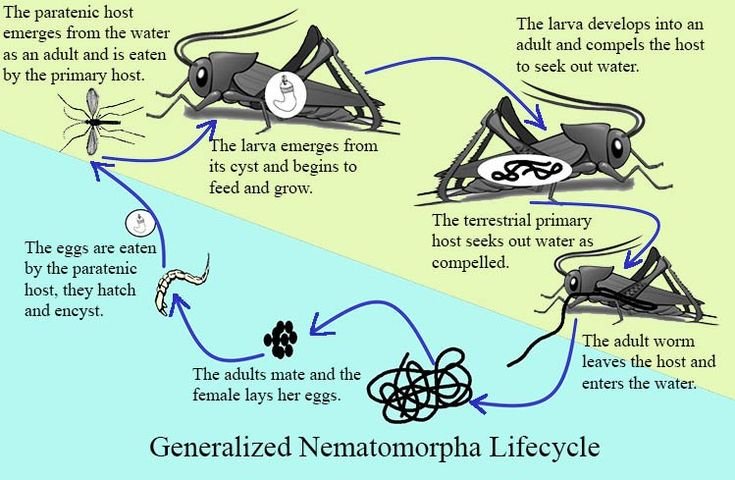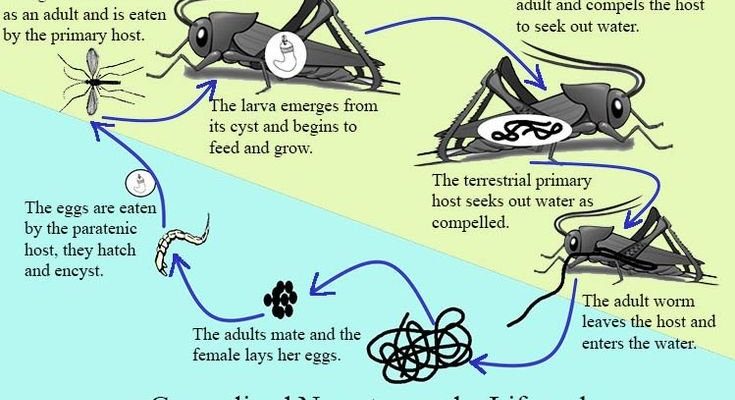
Imagine a creature that starts its life in water as a tiny larva, only to grow into a long, squiggly worm that manipulates its host to jump into water. It’s like something out of a science fiction movie, where the characters don’t just exist but actively control others. Throughout this article, we’ll dive deep into the life cycle of nematomorphs—from their beginnings in aquatic environments to their peculiar adult behaviors. So, grab your coffee, and let’s unravel the mysteries of these quirky worms.
What Are Nematomorphs?
To kick things off, let’s clarify what nematomorphs are. These worms belong to the phylum Nematomorpha and are primarily known for their elongated, thin bodies that can measure anywhere from a few millimeters to over a meter long. They are often found in freshwater habitats but can also thrive in moist environments on land.
Here’s the thing: nematomorphs are not just ordinary worms. They have a unique relationship with insects, particularly grasshoppers and crickets, which serve as their hosts during a crucial part of their life cycle. This relationship is where things start to get interesting. As parasites, nematomorph larvae manipulate their hosts in some fascinating ways, which we’ll explore further in this article.
Stage 1: The Eggs
The life cycle of the nematomorph begins when adult females lay eggs in water. These eggs are tiny and usually stick to vegetation or debris underwater. It’s almost like they’re planting seeds for the next generation. When conditions are just right—warm temperatures and plenty of moisture—the eggs hatch into larvae.
You might be wondering, what happens next? Well, these larvae are not content to stay in one place. They actively swim and search for a host. The world is their oyster, but they have to be picky. They need to find insects, preferably grasshoppers or crickets, to continue their development.
Stage 2: The Larval Stage
Once a nematomorph larva finds a suitable host, it does something remarkable. It penetrates the insect’s body, often through the digestive tract. Inside, it starts to grow and develop. But here’s the twist: during this time, the larva doesn’t just grow silently; it influences the behavior of the host.
Imagine being in a trance where your thoughts and actions are not your own. That’s kind of how it is for the infected insect. The nematomorph larva compels its host to jump into water, where the worm can emerge and continue its life. This mind control is one of the most intriguing aspects of their life cycle, demonstrating the complex relationships in nature.
Stage 3: The Transition to Adult Stage
Once the infected insect jumps into the water, the nematomorph larva begins its transformation into an adult worm. This stage is all about growth and development. The larva sheds its skin several times, gradually elongating and developing reproductive organs.
Let me explain: adult nematomorphs typically have a long and slender shape. They can vary in color, but many have a brown or cream appearance. After a few weeks, they are ready to emerge from the host. When the adult emerges, it leaves the insect behind, often leading to the host’s demise. It’s a harsh reality of nature, but that’s life in the wild!
Stage 4: The Adult Worm
As adults, nematomorphs are free to swim and reproduce. They spend their time in freshwater environments, looking for mates to continue the cycle. The adult worms can live for several months, during which they mate and lay eggs, continuing the cycle—all while embodying their extraordinary life story.
Adult nematomorphs are quite different in behavior than their larval stage. They are more active, swimming gracefully through the water, often gathering in groups. Here’s a fun fact: they can even be seen dancing on the surface of the water during mating rituals. It’s like a lively underwater party!
Behavior and Ecological Role
So, what’s the point of all this? Why should we care about nematomorphs? Beyond their fascinating life cycle, these worms play a significant ecological role. As parasites, they help regulate insect populations, contributing to the balance of ecosystems.
Their unique behaviors also make them a subject of study in various scientific fields. Researchers are interested in understanding how nematomorphs manipulate their hosts and the implications this has for our understanding of parasitism and behavior in the animal kingdom. Plus, their complex life cycle adds to the rich tapestry of life on Earth.
The life cycle of the nematomorph is a captivating journey that highlights the wonders of nature. From eggs to larvae to adult worms, each stage is filled with remarkable transformations and behaviors. Understanding these creatures not only enriches our knowledge of biodiversity but also gives us insight into the intricate and often surprising relationships that exist in ecosystems.
Next time you encounter a worm, think about the life cycle of the nematomorph and the wild journey it has taken. In a world where even the smallest creatures have complex lives, it’s a reminder that there’s always more to discover—if you just take the time to look.

